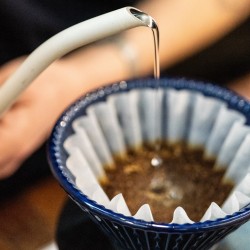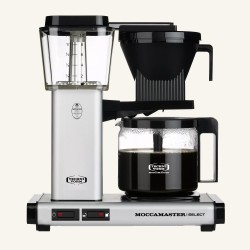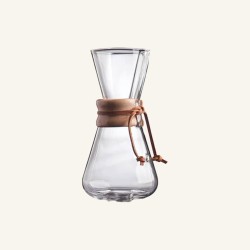
These methods mean the coffee is in contact with the water for some two to four minutes favouring the extraction of the caffeine and therefore of the bitterness. As the profile sought for is usually lightness, purity, finesse and the absence of bitterness, the roasting method must be light with beans still slightly wrinkled but cooked to the core. Please find below a list of pieces of equipment for the gentle method of making coffee.
Hario V60:
To make V60 coffee you must have a porcelain or copper dripper, a borosilicate glass carafe together with paper filters. Not forgetting coffee specially roasted for gentle methods. The filter is the method enabling the purest yield in the cup and can restitute the finest and most volatile of aromas of the floral type by using a filter that is however relatively porous.
Profile :Clear liquid similar to tea, a light, acidulous mouthfeel depending on the coffee used, wonderful restitution of any type of aroma
Chemex:
To make coffee with a Chemex you will need the coffee maker and filters of the same brand. While still remembering to use roasted coffee appropriate to gentle coffee making methods. The Chemex is a coffee maker with specially designed filters invented in 1941 by chemist Peter Schlumbohm in the US. It is exhibited on a permanent basis in the Museum of Modern Art in New York and in New York’s Corning Museum of Glass.
Coffee maker profile:Apart from its design, what differentiates a Chemex® from a V60 Hario® or any other filtration system is its thick filter with little porosity thus allowing the flow-through of very little matter. The result in cup is therefore very pure, perhaps even too pure as the best coffees are hard put to express themselves fully with this method.
Piston coffee maker:
Invented in France in the mid 19th century, the piston coffee maker is still one of the most popular methods worldwide. English speakers call it the French Press while the French prefer calling it the Bodum® coffee maker, from the name of the Danish company which made it the flagship of its coffee range. It is really the easiest method to use. This is pure infusion from which the grounds are removed by pressing them down to the bottom of the coffee maker. It could be said that the method is Brazilian minus the grounds.
Profile: A cup with mouthfeel, pleasant enough but which lacks purity due to a high level of sedimentation. It is very important to pour all the liquid into another container or to serve it all in cups. If you leave it untouched in the piston, infusion continues and the juice becomes bitter.
Aeropress:
Invented in the US in 2005, Aeropress uses a chamber and plunger with an integrated paper filter. An association of infusion and filtration, it could be said that a French Press coffee is obtained although filtered with little pressure. An interesting mix of infusion and percolation with little pressure.
Profile: Average but pleasant mouthfeel with roundness and relative purity. The Siphon, invented in France around 1825 is designated a depression siphon coffee maker as the extraction process is filtration by depression. Made up of two glass globes set one above the other and secured to a holder, it functions using the principle of expansion and contraction of steam. What a fine object and how nice to watch but far from simple to clean. The cup result is irrefutable and could be compared to a filtered French Press coffee.
Profile: Very similar to filtered coffee, very pure as it is filtered, roundness is highlighted. To make a good coffee, you must also have: A coffee grinder/mill for optimal grinds: To obtain a good coffee, it is vital to grind it just before extraction with a grind appropriate to the method of use. That requires a mill with adjustable grinding wheels. Rotary coffee grinders do not allow precise grinds and burn the coffee. You can obtain very good results with small manual grinders like the Comandante® or the Hario®. You can also purchase electric mills with grinding wheels such as the ENCORE or the Sette 270 by Baratza. They should incidentally be designated as crushers as their two flat or conical grinding wheels will crush the coffee micrometrically. Some crushers focus rather on gentle methods while others are specifically intended for espresso coffee. Some are designed for the two methods. A kettle for the right temperature: Good control of the temperature of the water used is a basic requisite for good results. It varies depending on the method, the degree of coffee roast and the result expected. To achieve the above there are kettles on the market with very precise temperature control systems like the Artisan by Brewista® or the Buono Kettle by Hario® that also enable water temperature to be maintained. You can also make use of small thermal probes offering precision and are not at all costly.
A digital scale for accurate weighing:
a small kitchen digital scale with indication of tare weight should be enough. Some equipment, of the Acaia or Hario type are specifically designed for coffee. They are watertight and display timed extraction progress.




